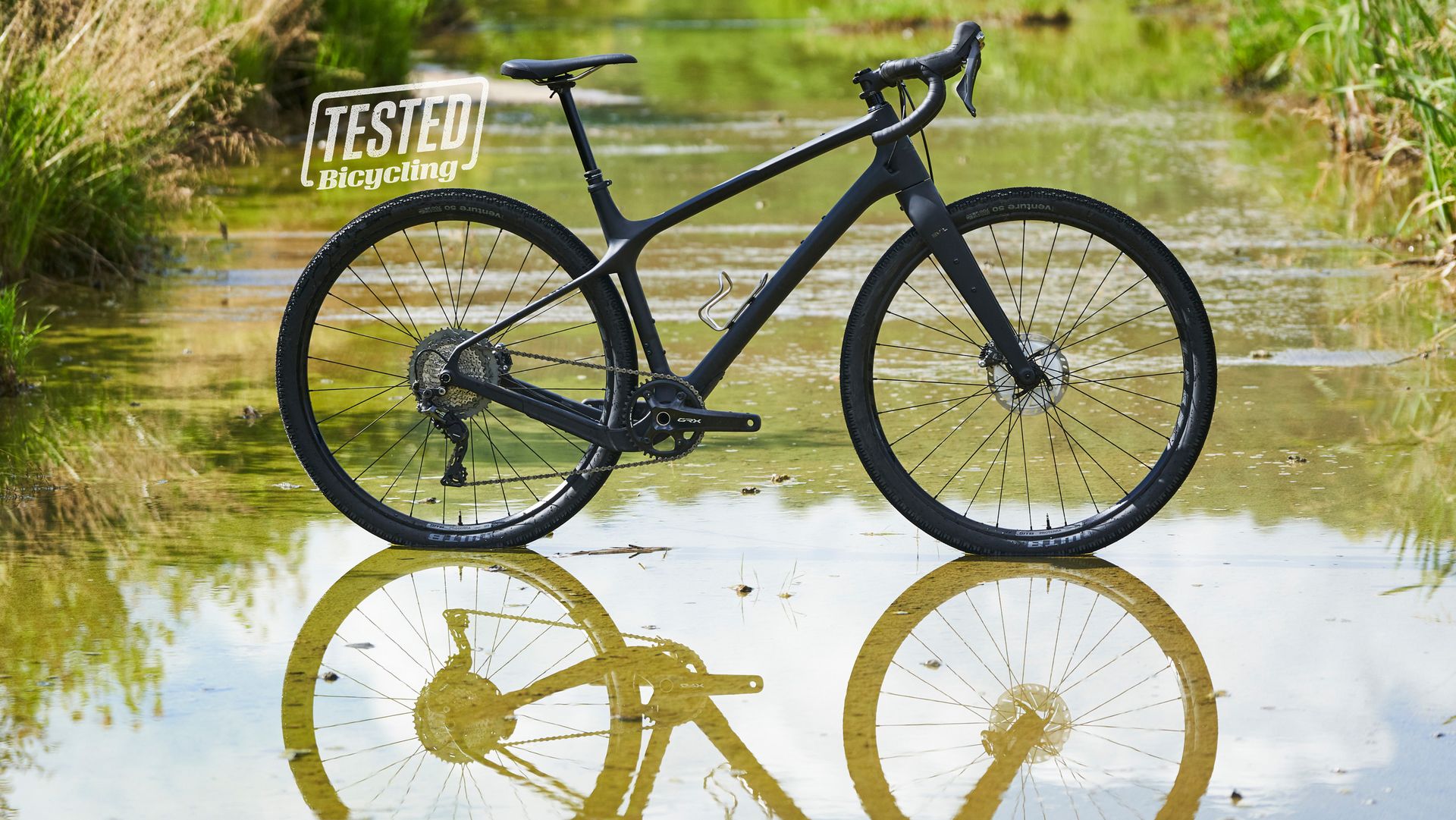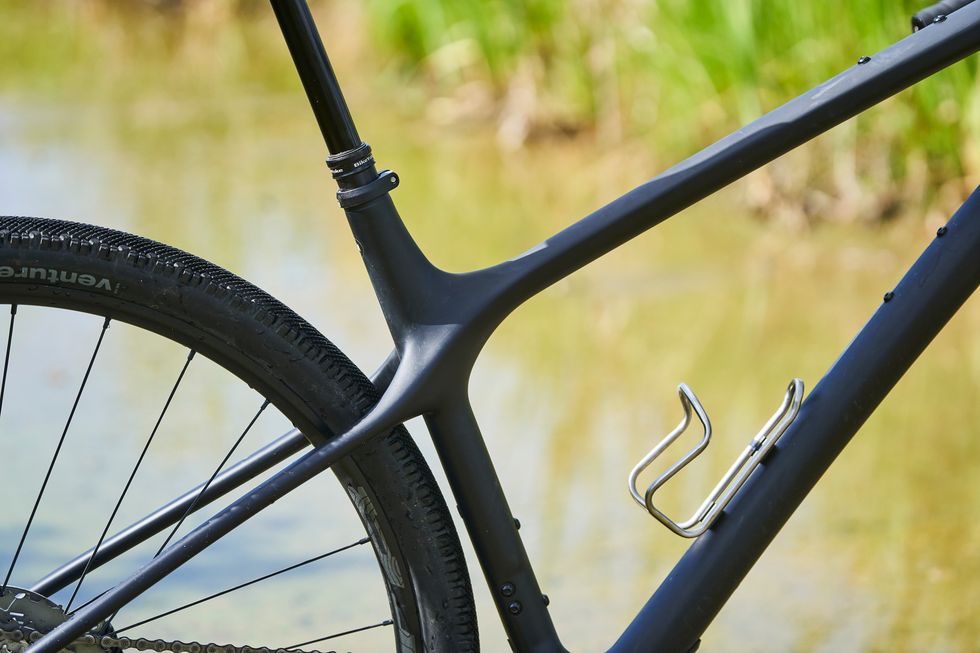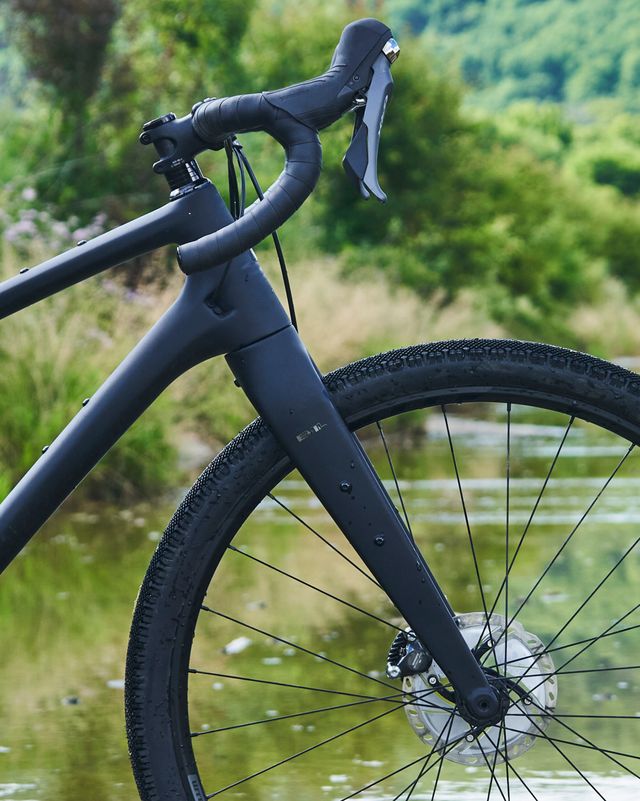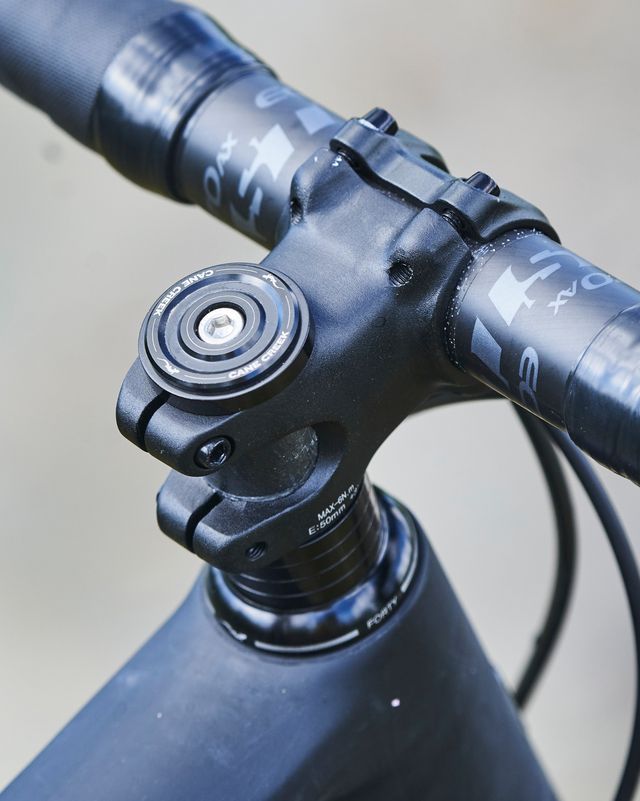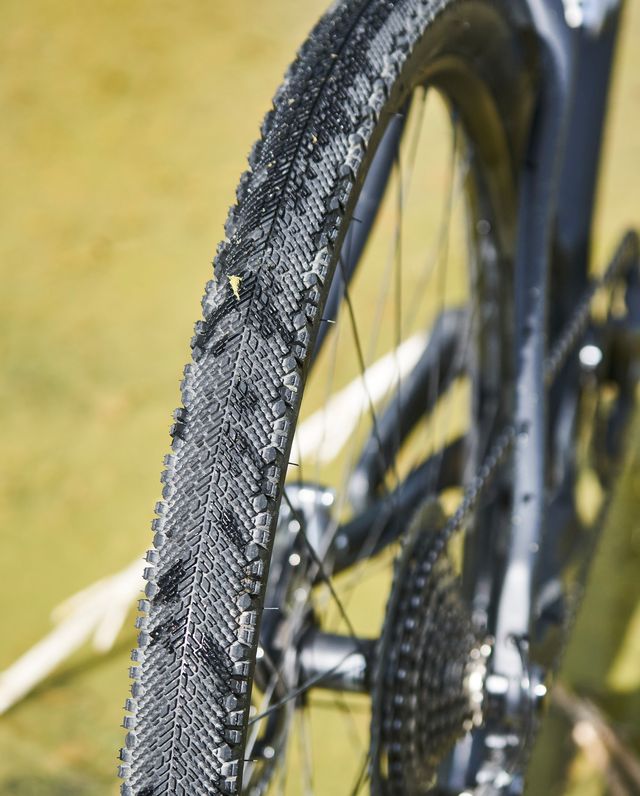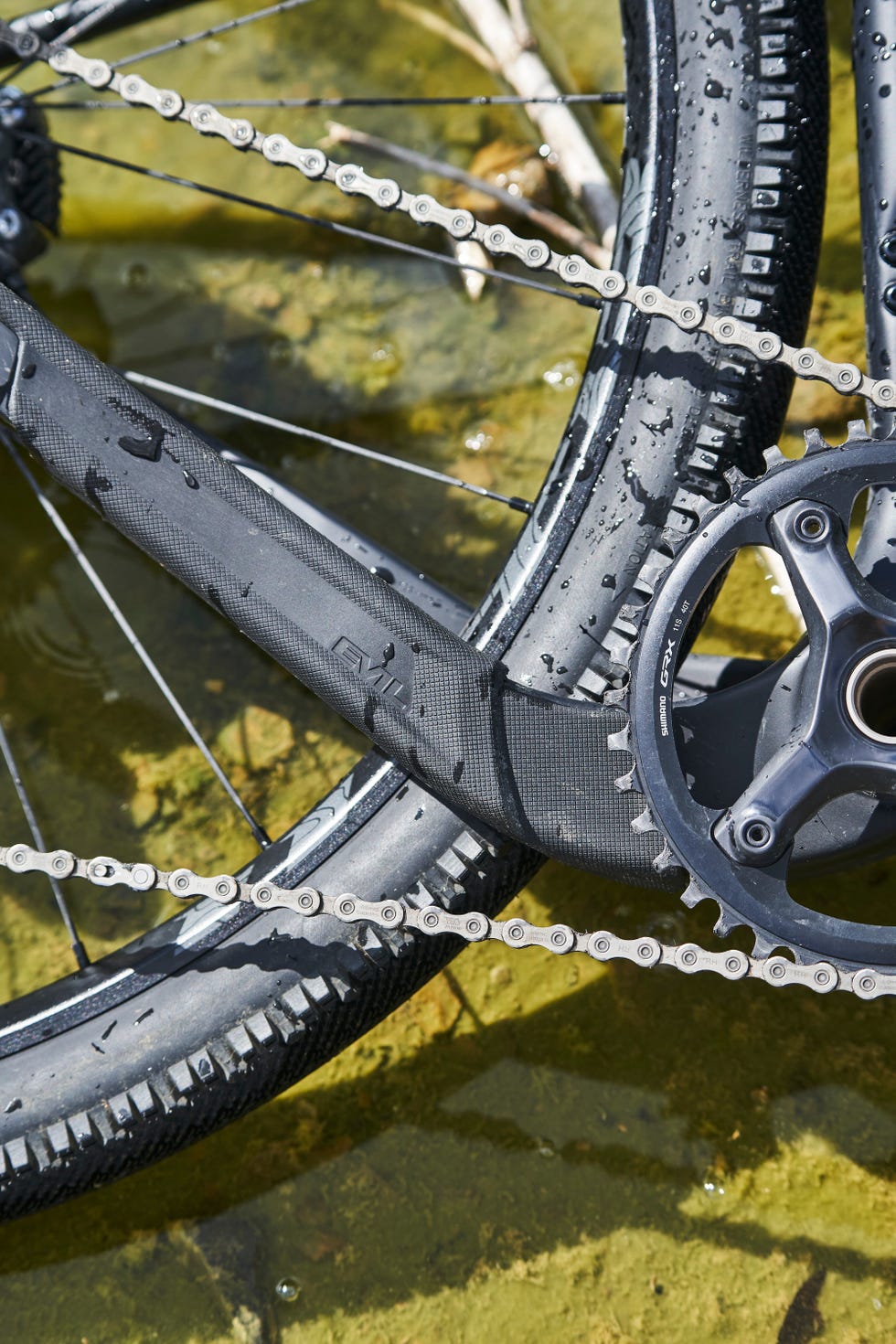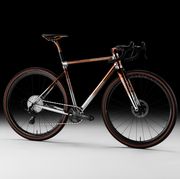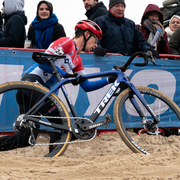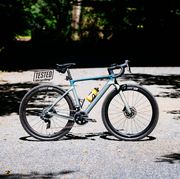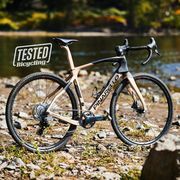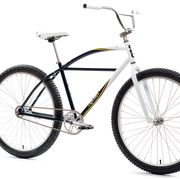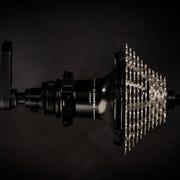The Takeaway: This is an adventure machine built for gravel roads, dirt trails, and for riders who like to get wild.
- The slack 66.67-degree head tube gives it tons of stability.
- It’s strong enough to survive legit dirt jumps, but that makes it feel less compliant than some others.
- Despite its radical frame shape, you can still get in an aggressive position for hammering on gravel roads.
Price: $4,799 (with Shimano GRX)
Weight: 20.9 lb. (M)
Evil’s Chamois Hagar is a wonderfully divisive thing. Even in the still-developing category of gravel bikes, where experimentation happens more freely than with road or mountain bikes, the Chamois draws attention and criticism.
In form and purpose, this bike resembles a mountain bike more than any other gravel model available—even those like Niner’s MCR and Cannondale’s Topstone that employ suspension. Unlike those bikes, which have mountain bike components on more traditional gravel frames (which is a slight derivative of a ’cross frame, which is a slight derivative of a road frame), the Chamois has the long sloping lines and relaxed angles of a modern enduro mountain bike. But is a gravel bike that feels more like a mountain bike than a ’cross bike a good thing? How you answer that question likely determines which side of the divide you fall. After two months of testing that included everything from singletrack sessions to mixed-surface rides to all-day gravel grinding, I’ve landed solidly on the side that believes that unconventional thinking driving the Chamois led to something special. With the Chamois, Evil created a bike that’s not only capable of fast gravel rides and bikepacking adventures, but that also has the stability, calm steering, and strength to be ridden aggressively anywhere.
Kevin Walsh, the owner of Evil Bikes, and longtime design partner Dave Weagle collaborated on the frame. Both spend more time on mountain bikes than on road bikes, and those experiences influenced the design. “It’s basically a road bike crafted into the Following,” Walsh said, referring to the company’s groundbreaking mountain bike.
The Following is proof that good things happen when the two collaborate. Introduced just as mountain bikes with 27.5-inch wheels were taking over, it was designed around the larger 29er size, and had the slack angles of a downhill bike and the travel of a cross-country bike. It immediately changed the course of mountain bike design. Now, nearly every brand has a comparable model.
Walsh and Weagle drew on that history when developing the Chamois. “Our only boundaries were the mechanical ones,” Walsh said, meaning bottom bracket and axle standards dictated aspects of frame design. Everything else was wide open. Foremost, they wanted to remedy the twitchy steering they felt while riding in the drops on other gravel bikes. They wanted more stability, especially when bombing down dirt roads. And they wanted a bike strong enough to be ridden a little recklessly, the way the two ride their mountain bikes.
There was something else, too. Before starting Evil, Walsh owned a design agency that did work for Red Bull, Jones Soda, and others. He gets the appeal of visual identity and the role it has in attracting fans to a brand. Around the same time that his team began developing this new bike, they were also redesigning two of the company’s most popular models: the Wreckoning and the Following. The Chamois Hagar shares some distinctive design language with those mountain bikes—a steeply sloping top tube that flares around the seat tube with shapes that look almost reptilian; a vertical compactness that exaggerates the distance between the axles, making it look like some forces took hold of a traditional frame and stretched it end to end almost to its breaking point. It looks unconventional, and that’s the point. “We came at this fresh,” said Walsh. “We weren’t concerned about designs anchored in tradition.”
To make the bike feel stable and “less twitchy,” Evil engineers gave it a 66.67-degree head tube, 80mm of bottom bracket drop, and lots of reach (420mm on a size medium). There’s a 57mm offset fork and 93mm of trail. That gathering of numbers and angles works collectively to calm things down as the dust starts flying.
This changes the way you ride this bike compared to other gravel bikes. On the Chamois, you steer from behind the front wheel, instead of over top of it. There’s more leaning and twisting of the hips to set up turns. It’s a more dynamic activity, which may feel uncomfortable at first to people used to more traditional road-based geometry. You need to work it around tight switchbacks more. When you stand to punch up a double-digit grade, the bike doesn’t sway and counterbalance beneath you. It wants to stay upright, and the wheels remain in line. Until you get used to it, that can make the bike feel like it is fighting against you.
What’s most surprising is how nice the Chamois feels when you’re on flatter ground, the type of terrain you picture when you think of gravel races like Rebecca’s Private Idaho. Despite the bike’s unconventional geometry, your key points of contact—seat, feet, and hands—remain in a typical position. That makes the bike feel fast and efficient when you’re in the drops; it still reacts quickly to your commands.
Adding to that efficient feel is a remarkably stiff frame that Evil intentionally overbuilt to withstand levels of abuse that would crush many gravel bikes. “We know our clientele and they’re a bunch of derelicts,” Walsh joked. So you can slam into ruts going downhill at 50 mph and not worry about your head tube ripping off, he says. Or launch over a 25-foot double like some Evil-sponsored riders, or, like I did, hit a front-yard booter with a flat landing without worry.
Incredibly, the Chamois Hagar is relatively light. Our size-medium test bike weighs just over 20 pounds with a mid-priced collection of parts. (The company claims an unpainted frame weighs 1,164 grams and the fork is another 467.) What it’s not is supple. Making a bike this stout also makes it rigid. You feel small bumps, and harder ones send shockwaves through the frame. The dropper post—essential, given the bike’s intended use—takes away any opportunity to reduce vibrations by using a more forgiving post.
You can run tires up to 50mm wide on 700c rims, and that helps absorb some of the chatter. But in one concession to traditional gravel/road standards, the Chamois uses a 142x12mm rear axle and 100x12mm front instead of the wider Boost spacing common on mountain bikes. That means you can’t run wider tires.
What you can do, though, is attach a ton of bags and bottles to the frame. There are seven mounts as well as connections for fenders or mudguards. The sloping top tube limits what bags will fit inside the frame and the size of the bottle you can squeeze into the forward down-tube mount, but cargo capacity is ample (you’ll need a seat bag made for a dropper or an adapter that won’t mar the post).
Here’s something else to consider: In price and performance, this is also a relatively accessible bike. The GRX model I tested sells for $3,899 (though updates since then have pushed similar versions up to $4,799). That’s comparable to a similar Trek Crosscheck and $600 less than a Santa Cruz Stigmata with similar builds (though neither of those comes with a dropper post). And the same geometry that makes this the most aggressive gravel bike oddly makes it one that’s great for newer or casual riders. The sloping top tube and the ability to drop the saddle makes it easier to get on and off, especially when you have groceries or a six-pack in one hand. And the slower steering and stable ride you want on singletrack adds a pleasing calmness while navigating city streets and recreational paths.
A lifelong friend of mine, Roger, recently started riding, mostly on our local rail trail network. As his weekly mileage increased, he traded his hybrid for a gravel bike, choosing the Chamois Hagar after testing a few models. The dropper post, calm handling, and connection to the brand appealed most to him. Soon after his purchase, the duration and frequency of his rides started increasing. Several times a week, he hit 25 or 30 miles. And then toward the end of my test of the Chamois Hagar, we drove to the rugged hills in the center of Pennsylvania and rode 50 miles up and down again through budding mountain laurel on dirt roads that were smooth clay in some areas and a mosaic of limestone and shale in others.
Those of us who ride lots know that we connect with bikes in ways that can’t be measured in frame angles and top-tube lengths. On the right bike, we see some of who we are and the type of rider we aspire to be. I’m not sure Roger and I would have made that trip if he had purchased another bike. The Chamois Hagar is not for everyone. And like many first-generation models, it has imperfections. But those imperfections are easy to overlook if this bike speaks to you the way it did to Roger, the way it does to me, the way I think it may to a lot of cyclists looking for a fast, steady, trail-ready drop-bar bike on which you can do dumb things and fulfill your most far-out adventure fantasies.
